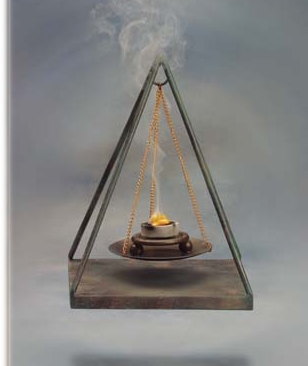Incense ... 
The entire apartment was full of thick smoke! It was a known smell. The smell of incense that only Muslims use. It was three months after we had stopped doing what the Imam (Muslim priest, prayer leader and elder of mosque) had told us to do. But we realized that the effect had remained. The Imam had said that his prayers are with us! Even though the incense lumps were all used up and we stopped burning them, the effect remained.
 I realized that when I recalled, it had been a little while after the sudden and tragic demise of my mother that me, my father and my younger brother found ourselves desperate to find solace in any way possible. We were suspecting that jealous relatives might played a part and may have resorted to black magic for such a terrible calamity, that my mother passed away. The suspicion was late confirmed to be true.
I realized that when I recalled, it had been a little while after the sudden and tragic demise of my mother that me, my father and my younger brother found ourselves desperate to find solace in any way possible. We were suspecting that jealous relatives might played a part and may have resorted to black magic for such a terrible calamity, that my mother passed away. The suspicion was late confirmed to be true.
We used to stay in a rented house at Panipat in the Indian state of Haryana and it was the Land Lady who once told is about the Mazar/ Dargah (Mausoleum) at Qalandar Chowk, 1 it was a walking distance from home.
We went to consult an Imam there. He understood that we were in deep shock and he consoled us well and as doze of revival he had asked us to burn the incense every evening after sun down. So we did for the next three months. It did help us to lead our lives normally again.
That day we had gone to the market and the entire apartment was locked. Still out of no where, the room was full of smoke. In the locality where we had that rented apartment, we had no Muslim neighbor. Such an incense is traditional to Muslims only. a thorough search of the house did not reveal any thing burning. Still there was smoke and the smell remained till 4 am the next morning!
Then realized what had happened! There was a crematory near by... it is very much possible that bad vibes had turned our way and the incense some deterred it. That's the only possible explanation!
1. Sheikh Sharafuddeen Bu Ali Qalandar Panipati (born 1190 CE, Ganja, Azerbaijan) was a Sufi saint who lived in India. His mausoleum in the town of Panipat is a place of pilgrimage. The dargah (mausoleum or shrine), mosque and enclosure at the Qalandar Chowk in Panipat were constructed by Mahabat Khan a Muslim noble in service of the Mughal Emperor Jahangir. Mahabat Khan's own tomb in red sandstone is adjacent to the saint's mausoleum. The tombs of Hakim Mukaram Khan and the Urdu poet Maulana Altaf Hussain Hali are also located within the enclosure. The left wall of the mausoleum has a qasida (panegyric) embossed and painted in blue and gold, written by Zahuri Neishabouri who visited India during the reign of Akbar. A large number of people from all walks of life - Hindus, Muslims, Sikhs and Christians - visit the tomb and offer prayers there each Thursday.
All rights reserved © Sudip K Ghosh aka *~Anecentric